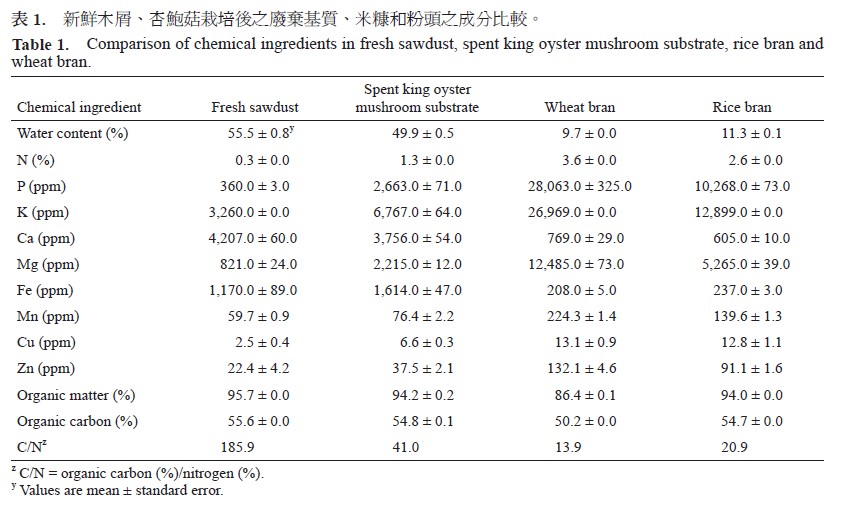All issues

Author:Mei-Hsing Chen, Wei-Sung Li, Kaun-Tzer Wu, Shiuan-Yuh Chien, and Yun-Sheng Lue*
Abstract:
Sawdust is a main ingredient for cultivation of edible mushrooms. In Taiwan, the annual demand of sawdust for mushroom production has increased to more than 350 thousand tons in recent years. Using sawdust for mushroom production is not only expensive but also environmentally unsound. In Taiwan, an estimated 200 thousand tons of spent mushroom substrates were produced annually and most of them were used as organic compost for growing crops. However, most of the spent mushroom substrates are nutrient rich and they are of potential for reuse in growing mushrooms. The objective of this study was to determine the feasibility of production of phoenix tail mushroom (Pleurotus sajor-caju), Bunashimeji (Hypsizygus marmoreus), and sunny mushroom (Agaricus braziliensis), using spent king oyster mushroom (Pleurotus eryngii) substrates collected after harvesting as an ingredient in the growth substrate. The ratio of fresh sawdust (Trema orientalis) and spent king oyster mushroom substrate in the growth substrate was 2:1, 1:1, 1:2, or 1:0 (w/w, dry weight) for the production of phoenix tail mushroom and Bunashimeji; and 1:0, 2:1 or 1:1 (w/w, dry weight) for the production of sunny mushroom. Results showed that yield of phoenix tail mushroom in the growth substrate containing fresh sawdust and spent king oyster mushroom substrate at 1:1 or 1:2 ratio was not signifcantly different from the treatment of 1:0 (fresh sawdust alone). Yield of Bunashimeji in the treatment of fresh sawdust and spent king oyster mushroom substrate at 1:1, 2:1, or 1:2 ratio (w/w, dry weight) was higher than the treatment of 1:0. For sunny mushroom, yield was the highest in the treatment of fresh sawdust and spent king oyster mushroom substrate at 1:1 ratio (w/w, dry weight). These results suggest that the spent king oyster mushroom substrate can be used to replace fresh sawdust for production of phoenix tail mushroom, Bunashimeji and sunny mushroom and the optimum rate of spent king oyster mushroom substrate for mushroom production varies with mushroom species. In addition, the use of spent king oyster mushroom substrate will reduce the demand of fresh sawdust and, thereby, reduce the mushroom production cost and improve environmental health.
Key words:Spent substrate, Pleurotus eryngii, Pleurotus sajor-caju, Hypsizygus marmoreus, Agaricus braziliensis
Download:![]() PDF Links
PDF Links
- 1. Using Digital Soil Mapping to Predict Soil Organic Carbon Stocks in Zhuoshui River Basin
- 2. Taxonomic Review of the Genus Asiophrida Medvedev, 1999 in Taiwan (Insecta: Coleoptera: Chrysomelidae: Galerucinae: Alticini), with Notes on Biology
- 3. Development of a Technique for Forecasting (or Pre-Detection) Anthracnose Disease Incidences of Green Mature Bagging Mango Fruits
 Submit your manuscript
Submit your manuscript
 Guide for authors
Guide for authors